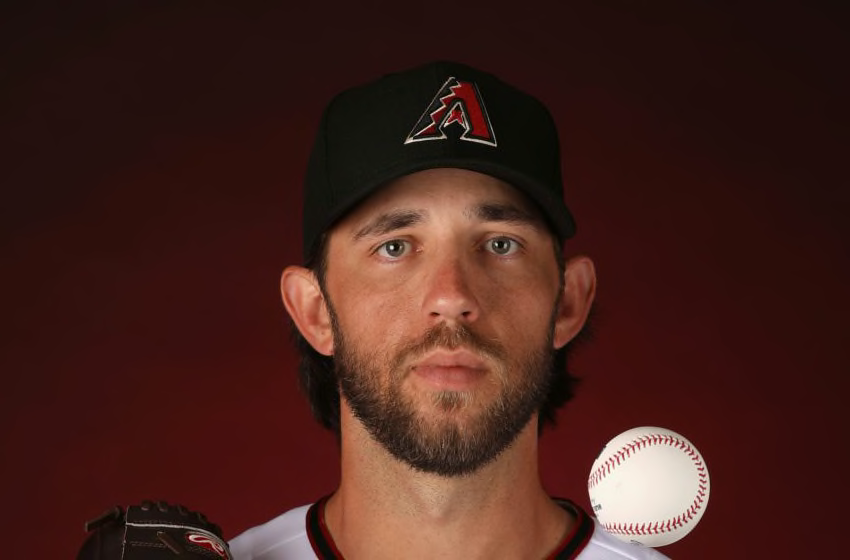
GLENDALE, ARIZONA – FEBRUARY 21: Pitcher Madison Bumgarner #40 of the Arizona Diamondbacks poses for a portrait during MLB media day at Salt River Fields at Talking Stick on February 21, 2020 in Scottsdale, Arizona. (Photo by Christian Petersen/Getty Images)
The Arizona Diamondbacks added Madison Bumgarner in hopes he could push them over the top into Wild Card contention. Is the veteran lefty enough for last year’s NL West runners up?
There were plenty of difference-making MLB moves over the offseason where players switched teams.
Gerrit Cole to the Yankees. Mookie Betts to the Dodgers. Josh Donaldson to the Twins.
Would legendary San Francisco Giants lefty Madison Bumgarner leaving the Bay Area to head to Arizona qualify as one of those huge acquisitions? I’m not convinced.
Giving a starting pitcher who turns 31 on Aug. 1 five years and $85 million is not a good long-term investment, but this question is whether his addition is enough to bring the Diamondbacks back to the playoffs for the first time since 2017.
Will MadBum help? Yes, but not as much as people think. Bumgarner’s best days are behind him, that’s for sure.
After combining for just 240.2 innings and 210 strikeouts over 2017 and 2018, Bumgarner fanned 203 batters in 207.2 frames last year. Those are vintage numbers. But the Giants southpaw had a career-worst 3.90 ERA that looks even worse when you factor in his 4.31 xFIP. He surrendered a career-worst 30 home runs despite only 12.8 percent of his fly balls leaving the yard, which is fortunate considering his groundball rate was a career-low 35.8 percent.
To go with those troubling peripherals, Bumgarner can no longer rely on the pitcher-friendly confines of Oracle Park. Baseball-Reference‘s Park Factor stats rates ballparks as being batter friendly if they have scores over 100, and pitcher friendly as being under 100. Oracle was a 90 for pitching and an 88 for hitting last year, with a 95 and 94 multi-year rate. Chase Field had hitting and pitching rates of 99 last year with a multi-year factor of 101. Certainly not as bad as people think of Arizona, but less favorable for pitchers like Bumgarner.
To compound that issue, Bumgarner was 6-2 with a 2.93 ERA in 19 home starts in 2019 and 3-7 with a 5.29 ERA on the road. Add up all these statistical issues, and you’ll see why Bumgarner’s signing with the DBacks may not be as great as his overall reputation would indicate.
Luckily for Arizona, it made plenty of good moves to bring the team in a more positive direction.
Outfielder Starling Marte comes over in a trade from Pittsburgh for a couple of minor leaguers after posting career-bests with a .295 average, a .503 slugging percentage, .845 OPS, 23 homers and 82 RBIs to go with a strong 25 stolen bases. He and free agent signing Kole Calhoun, who walloped 33 dingers in 2019, will replace Stephen Souza Jr. and Adam Jones, who each had disappointing tenures with the Snakes. They also lost outfielder Jarrod Dyson’s 30 steals, but his .230 average and .313 on-base percentage aren’t worth giving him another 400 at-bats in 2020.
After a pu-pu platter of Alex Avila and John Ryan Murphy backing up starting catcher Carson Kelly last year, Arizona upgraded by signing former All-Star Stephen Vogt, who had 10 homers, 40 RBIs and a .490 slugging percentage in 280 plate appearances with the Giants last season. And righty relievers Hector Rondon and Junior Guerra will replace Yoshi Hirano, moves which are basically a wash when it comes to the bullpen.
Arizona faces other overarching questions with its returning players. Can Ketel Marte prove his breakout 2019 season wasn’t a fluke? The same goes for 29-year-old first baseman Christian Walker, who cranked 29 home runs in 2019 after playing just 61 career games prior to that. Can the D-Backs get another strong season out of Nick Ahmed? What can Jake Lamb contribute?
On the pitching side, can Zac Gallen and Mike Leake provide quality rotation depth behind Bumgarner and Robbie Ray? Is Archie Bradley ready to be the full-time closer?
Madison Bumgarner is still an above average Major League baseball player, but his days of swinging playoff races and pennant chases are over. For Arizona to return to the postseason, it needs its new signings and returning players to all contribute to turn a solid group into a playoff team.